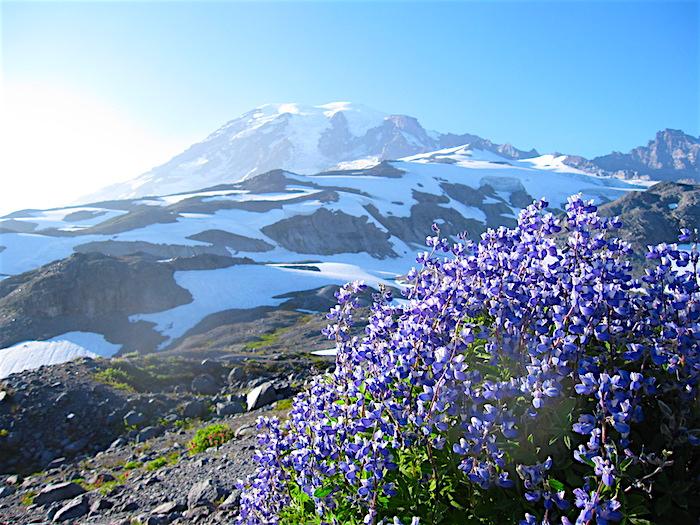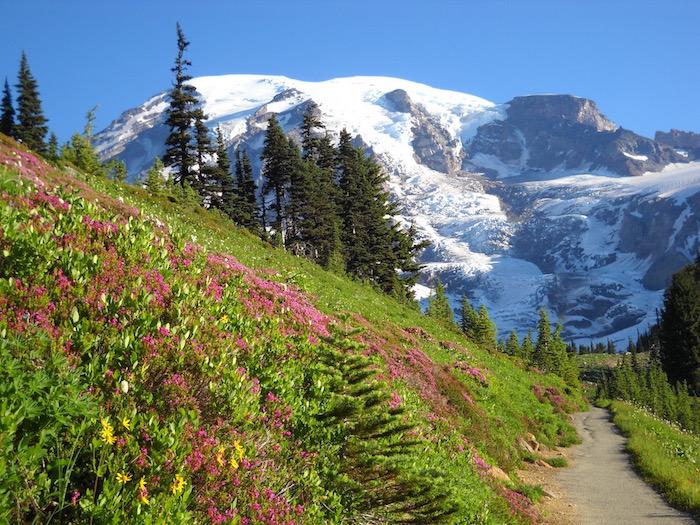
Climate change is driving changes in the blooming of wildflowers at Mount Rainier National Park/Elli Theobald
Riots of blooming wildflowers are one of the joys of visiting national parks, but climate change is tinkering with the schedule of some of those flowers. At Mount Rainier National Park in Washington, for instance, all wildflower species are blooming earlier than in the past, roughly half have extended their season, and a little less than half shortened theirs, according to research conducted by University of Washington personnel.
A trio of ecologists from the university stumbled upon this alteration while collecting data on the subalpine wildflowers that bloom each summer on the slopes of Mount Rainier. As they report in a paper published online last month in the journal Ecology, an unseasonably warm, dry summer in 2015 caused reassembly among these subalpine wildflower communities.
The conditions in 2015 gave the team — consisting of doctoral student Elli Theobald, doctoral student Ian Breckheimer and biology professor Janneke Hille Ris Lambers — a preview of what subalpine communities may look like by the end of this century. By then, significant climate change is expected to permanently alter environmental cues that wildflowers rely upon and make community reassembly a more common phenomenon — with unknown consequences for species interactions in those communities.
"2015 was such an outlier that it gave us a glimpse of what this environment on Mount Rainier might be like toward the end of this century," said Theobald, who is co-lead-author on the paper with Breckheimer. "Conditions were so warm that they affected the flowering time and flowering duration of species, forming communities in 2015 that simply did not exist in the other years of our study."
Their study is one of few to demonstrate evidence for community-level reassembly among multiple species.
"These reassembled communities could potentially change the interactions among wildflowers and other species in this subalpine setting," said Theobald.
For six summers from 2010 to 2015, Theobald tracked environmental conditions and plant behavior for 48 species at 70 field plots, each one square meter, along the southern slope of Mount Rainier. The plots ranged from 1,490 to 1,901 meters in elevation. Within each plot, Theobald used sensors to record temperature, snowmelt, and soil moisture content.
"At these elevations on Mount Rainier, snow is the major driver of plant behavior, because the annual cycle of flowering and reproducing cannot begin until the snow melts," said Hille Ris Lambers. "If there is snow on the ground, plants cannot photosynthesize, and if they cannot photosynthesize, they cannot grow."

All wildflower species at the park are blooming earlier, and a little more than half are staying in bloom longer/Gary Vogt file
When the sensors reported that snow had melted at each plot, Theobald collected data on when plants would emerge, flower, and begin to produce fruit. These included species familiar to hikers such as avalanche lily, magenta paintbrush, mountain blueberry, wild huckleberry and wild lupines.
Most of these plants are perennials, which retreat underground each winter. But when snow melts, they typically have a two- to four-month window — depending on elevation and position — to grow, flower and produce fruit and seeds for the next generation before snow returns.
In 2015, conditions were so warm that, on average, snow began to melt at the study plots 58 days earlier than in 2010-2014. The team recorded major shifts in the bloom times of wildflower species. All of the species — 100 percent — flowered earlier in 2015 and 54 percent of species also lengthened their flower duration that year, some by as many as 15 days. The remaining species showed shorter flower duration, in one case by nearly 19 days, possibly due to accelerated soil drying, altered pollinator activity or other factors.
Since species shifted in different ways, conditions in 2015 produced new patterns of reassembled wildflower communities, with unknown ecological consequences.
"These are species that have always coexisted at these subalpine sites," said Theobald. "But in 2015, we saw species flowering at the same time that normally flowered weeks apart."
The team saw the most dramatic signs of reassembly among plants that normally flowered early in the summer. These plants tended to grow at sites experiencing less snowfall — such as plots at lower elevations, or along ridges and slopes instead of coves and valleys, where snow tends to accumulate. In addition, the plants that tended to lengthen flowering duration did so if they experienced a greater number of warm, photosynthetically "productive" days in 2015.
Reassembly on the scale that the researchers saw in 2015 — and that Mount Rainier may see every year by the end of this century — may change interactions among species. For example, plants could compete for access to pollinators, which at Mount Rainier include bumblebees, flies and hummingbirds.
"We simply don't yet have enough information to know who the 'winners' and 'losers' of reassembly will be, or even what 'winning' or 'losing' in such a scenario would look like," said Theobald.
To predict that, scientists must observe and test how ecological reassembly affects reproduction for all species in these regions — from flowers and pollinators, to even the bears that feed on subalpine berries. These effects will also impact the people who visit these sites and try to preserve them.
"All of these interactions among species — and how those interactions will shift due to climate change — will affect how we manage these sites," said Hille Ris Lambers. "After all, Mount Rainier is a national park that is here for all of us, as well as the species that call it home."

Glacier lilies in bloom at Mount Rainier/Rebecca Latson file



Comments
Daily Caller? Oh that settles it for sure
Buck - do you have any more credible and less alanted sources? Daily Caller, fouinded by an aide to Dick Cheney, is filled with conspiracy nonsense and fringe right wing propaganda. If that's your alt3ernative to Faux lNews, that is like saying you switched from Navel Orange Juice to Valencia Orange Juice.
Nothing more slanted than someone conjuring up the DNC, Leftist hatchet job of Dick Chaney and efforts toward his personal distruction. Better clean your own nest, Rick. Dark side actions of your presumed heros from Clinton(s) through Obama and everyone they seemed to have corrupted are becoming more clear and provanble. You accept that and it will all become clear who the people are that are standing on solid ground.
So, Argalite and Rick B. What have both of YOU read that "settles it for sure?" And what do want your sources to "settle" in the first place? If all human knowledge has been "settled," what is there left to learn?
The Daily Caller may not have an open mind, but what media source ever has? Once it goes through someone's brain, who, what, why, when, and where are subject to distortion--especially why.
Why are we so concerned about global warming? What is the matter with a warmer planet, or is Hawaii the one out of touch? Funny thing, but no one I know here in Seattle is planning his or her "winter vacation" in Fairbanks, Alaska.
But! But! Sputter! Sputter! We all know that heat is bad! Yes, and so is cold when you have too much of it, Will anyone miss the cold?
The biology? Earth has been warming for 15,000 years. George and Gracie like saber tooth cats, but in pictures, thank you. Nor would they want me to being home a mammoth. But! But! Sputter! Sputter! I built my beach house on the beach! Then watch it wash away, you dummy. Same if you built it on a fault. As it stands, I'm 66 miles as the crow flies from the summit of Mount Rainier. Did I say summit? I should have said crater. Why are the only dummies in the world those who "deny" global warming? The human race has been denying worse for 10,000 years.
You can't sell it because, yes, global warming is something that needs to be sold. In the wake of the San Francisco Earthquake (1906), no one was sold on moving the city, either. In the wake of dozens of devastating hurricanes, Houston, New Orleans, Galvaston, Miami, etc., etc., etc., are still right where their founders started them.
Why? Because people LIKE living in those places, and accept the risks, Al Gore's preaching aside.
Now, where did I put my policy for earthquake insurance? Believe it or not, barely 15 percent of homeowners in Seattle have it. (I do). But I will not be buying any policy for "global warming." By then I plan on being dead.
Typical argalite and Rick B, don't like the facts try to blame the messenger. Daily Caller didn't do the study. An independent group of scientists commissioned by the US Department of Energy did the study. Daily Caller merely reported on the results.
And they aren't the only ones.
https://www.investors.com/politics/editorials/another-global-warming-stu...
Or do you want to claim Investors Business Daily "is filled with conspiracy nonsense and fringe right wing propaganda".
And they aren't the only ones reporting it.
https://www.investors.com/politics/editorials/another-global-warming-stu...
Do you believe Investors Business Daily "is filled with conspiracy nonsense and fringe right wing propaganda"?
The paper was published by The Asia-Pacific Journal of Atmospheric Sciences, a quarterly peer-reviewed scientific journal covering the field of atmospheric science. Is the APJA "filled with conspiracy nonsense and fringe right wing propaganda"?
Sorry everyone. In a moment of weakness I lost control and poked our local troll with a stick and woke him up. My apologies and I'll be going back to the real world now.